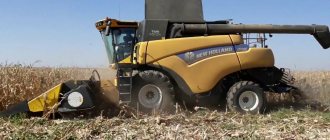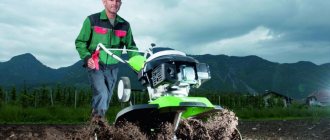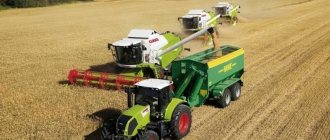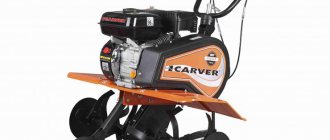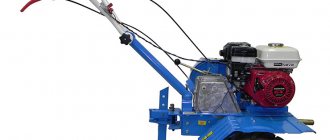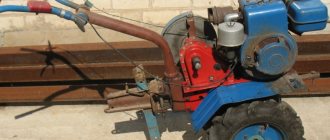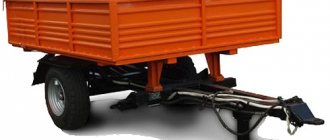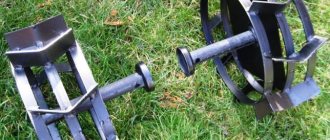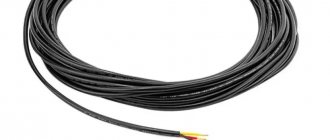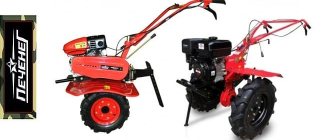RSM 161 is the latest 2-drum combine, occupying an intermediate place in the Rostselmash product line between the Torum rotary family and the single-drum Akros series. RSM 161 is positioned as special equipment of class 6, but in many respects it produces significantly higher performance. Despite the fact that the model appeared on the market relatively recently, consumers are showing significant interest in it.
The premiere of the RSM 161 took place in 2015, and mass production of the machine began at the same time. The first copy arrived in the Voronezh region at the Pavlovsk MTS. Even then, developers and experts did not skimp on their praise for the new product. In the summer of 2015, the combine underwent global field tests in diverse regions on fields with medium to high yields. The model was positioned as a technique for large farms and areas with increased productivity. At the same time, the machine was not afraid of straw, contamination and significant moisture in the harvested crops.
Externally, RSM 161 was significantly different from other Rostselmash products. When developing the exterior of the combine, a “geometric” style was used, which is quickly gaining popularity. The design of the model included 22 patented solutions, and the developers called the technology a representative of a new era.
Loud premiere “with a continuation”
On June 15, 2015, the first production RSM-161 rolled off the production line. Buyer No. 1, the head of Pavlovskaya MTS from the Voronezh region, Viktor Ivanovich Skutnev, was presented with the keys to the combine in a solemn ceremony. Rostov Governor Vasily Yuryevich Golubev and the Minister of Industry and Trade of the Russian Federation Denis Valentinovich Manturov took part in the launch of the first RSM-161 from the assembly line. Officials did not skimp on praise for the new combine, calling it “a machine of the 21st century.”
Ceremonial launch of serial production of "RSM-161".
And at the beginning of the harvest season, on July 17, 2015, from the Zernogradsky district of the Rostov region, we launched a large-scale demo tour of the new combine. "RSM-161" has passed field tests in many large farms in key agricultural regions of the country. The total distance he covered during the tour was 6,530 kilometers. The demonstration model "RSM-161" processed 122 hectares of planting areas and harvested 390 tons of grain crops.
The combine was tested on fields with different yields and in regions with different climatic conditions. This included the high-yielding fields of Bashkortostan and the high humidity of the Omsk region.
The company expects to sell at least four hundred RSM-161 units annually. Indeed, during the demonstration tour, the new agricultural machine performed very well, even in those conditions when other combines could not leave the field. "RSM-161" was initially positioned as a combine harvester for large farms, for regions with high yields; “not afraid” of difficult agro-climatic harvesting conditions - such as high humidity, weeds, and straw.
Externally, the RSM-161 is strikingly different from other combines (and from competitors too). The exterior of this combine departs from the established canons of industrial design of agricultural machinery. When creating the external appearance of the combine, the “geometric” style, fashionable in modern design, was used.
“RSM-161” was the result of the implementation of state contract dated May 21, 2012 No. 12411.0810200.20.V05 “Development of self-propelled grain harvesters on a single platform for inter-model unification of machines of classes 3, 4, 5, 6, 7 with classic, axial-rotor and mixed threshing and separating device." 22 patented inventions were included in the design of the machine. Rostselmash specialists call it the first-born of a new global platform, a whole family of high-performance combines. By 2022, it is planned to develop and launch into mass production at least five more models based on the RSM-161.
"Rostselmash": a large report from "PM" about Russian combines
The territory of the main production site of Rostselmash is huge - 148 hectares - and from a bird's eye view its outline resembles Africa. Therefore, employees answer the question “Where are you?” can easily answer: in South Africa, Congo or Tunisia.
Now we are at “Madagascar” - the plant’s exhibition area located slightly to the side. The machines displayed there are more reminiscent of the crawlers from Star Wars or harvesters from Dune and other science-fiction films rather than the agricultural machinery we are familiar with from old photographs.
This is not surprising - in English, a grain harvester is called Harvester.
The RSM 161 combine is on site - the first machine to be built on a new global platform based on modular architecture. The car, built from scratch, is aimed at conquering foreign markets, although no one forgets about the domestic one.
The charismatic marketing director Prokhor Darmov continuously pours out numbers: in the dashing nineties, Rostselmash set an anti-record, producing only 987 combines of outdated models in a year; the market share of combines in Russia at the beginning of the restoration of the company’s market position balanced in the range of 40-43%. And this year the production reaches 6,000 combines and the share exceeds 70% of the market. And what’s most interesting is that today Rostselmash owns 17% of the global market for harvesting equipment; its machines are touring the fields of the USA and Europe side by side with the equipment of its main competitors - the American John Deere and the German CLAAS.
However, at Rostselmash they prefer not to talk about the past; it’s only the future that really lights up everyone here. And it is before us - represented by the 7th class combine RSM 161. Since the design is modular, on this platform you can make combines of different performance and different designs - smaller and more classy.
There are eight classes of combine harvesters in total. The eighth is designed for harvesting good, high-yield fields, and the most common lower class of self-propelled combines is the 3rd, for small farms.
The first class consists of walk-behind tractors with a cutting function and a binder, and a zero class harvester is jokingly called a sickle.
Cockpit
Our visit to Rostov-on-Don turned out to be successful - the Rostov region has just harvested a record harvest in its history. We also managed to ride in cars. A convenient staircase leads to the cabin to a height of about four meters. To say that the cabin is huge is an understatement.
For example, I did not immediately notice the refrigerator that was lost in it. Three people can easily fit in the cabin, and two people have complete freedom there. The fifth point comfortably sinks into the sprung chair.
The combine has a very simple and indestructible shock-absorbing suspension, so the huge low-pressure wheels first fight against unevenness and vibrations, then the sprung cab, and the last frontier is the operator’s seat.
If previously combine operators tried to work at dawn or dusk and while away the afternoon in the shade, now the coolest and most comfortable place during harvesting is the air-conditioned cabin of the combine.
RSM 161 This is what one of the most high-performance combines in the world looks like from the inside. Capable of harvesting over 2000 hectares per season even in the most unfavorable conditions.
Place of "RSM-161" in the plant's product line. Purpose of the model
According to the plan, it is designed to fill the intermediate market segment between the popular classes of heavy combines - a promising market niche between Akros and Torum. According to one of the creators of RSM-161, Dmitry Inozemtsev, “back in 2009 it was obvious that there was a gap in our model range; we did not have a car for this market segment. And up to a thousand units of combine harvesters were sold there every year!”
Large grain-sowing peasant farms in Russia are now on the rise and need powerful and productive equipment. That is why in recent years there has been an increase in the demand for rotary machines. At the same time, due to difficult agro-climatic conditions (in particular, high humidity and weeds), many agricultural enterprises still prefer push-button combine harvesters.
Of course, Western-made combines are very powerful and comfortable; They are distinguished by high build quality and a solid margin of safety. But they are also very expensive. And, in addition, they are very difficult to maintain, demanding on the quality of diesel fuel, spare parts are expensive and are not always available. This is why consumers tend, in most cases, to choose domestic products.
The new RSM-161 combine is a 2-drum, 6-key machine. A few years ago, in its absence, Rostselmash specialists proved that a single-drum machine is optimal for harvesting grain. But now a 2-reel drum is also being produced. The advantage of a 1-drum combine is its willingness to compromise. This is a car, so to speak, for all occasions. But the approach is changing in accordance with modern requirements. After all, in fact, there are no universal machines, in the full sense of the word.
Two drums are especially effective in conditions of high humidity in combination with medium to high yields and requirements for straw quality, when there is an intention to save it for feed. The Rostov manufacturer is gradually moving away from the concept of a “universal product”, as from the legacy of a bygone era, in which farmers were content with no alternative. Potential buyers, who have become more solvent and demanding in recent years, are presented with differentiated offers.
"RSM-161" is intended for harvesting all classic grain crops: cereals and cereals, oilseeds and legumes, row crops. A high-performance machine, which is capable of processing up to two thousand hectares at the end of the season, produces up to forty tons per hour of regular time.
In general, there are three basic schemes of two-drum combines: accelerator-drum-beater; drum-beater-separator; drum-beater-separator-beater. The third option was implemented in the RSM-161 design.
RSM-161 combines mow, pick up cereal grains or other crops with further threshing, separation, and grain cleaning. Cleaned grain is accumulated in a bunker and then unloaded into storage tanks. After collecting food, he cleans up non-grain residues - he chops and scatters straw throughout the field. Or it can leave the straw intact during harvesting. The harvesting process is allowed on a flat field with a slope of up to 8 degrees in the main grain-sowing zone.
Video
The model was supposed to fill the market category between classes of heavy vehicles. In terms of characteristics, the equipment was head and shoulders above most of its analogues. In terms of performance, the PCM 161 was not inferior to the foreign John Deere 1550 CWS combine. The model began to be mass-produced in 2015, and the number of orders initially exceeded production volumes.
For all its modernity, PCM 161 has retained the main advantages inherent in the products. A well-known manufacturer that controls about 20% of the global agricultural machinery market has created a model that can compete on equal terms with Western machines. The PCM 161 design included 22 unique patented solutions, which allowed the equipment to operate in conditions under which other machines showed a sharp decrease in efficiency. At the same time, the price of the combine remained affordable for most consumers.
RSM 161 is intended for harvesting traditional types of grain crops: row crops, cereals, cereals, oilseeds and legumes. High productivity (up to 40 tons/hour) allows you to quickly complete the job. The combine selects crops and then threshes, separates and cleans the grain. The processed mass is stored in a bunker, which is subsequently unloaded into storage tanks. RSM 161 also works effectively with non-grain residues, crushing and scattering them across the field (storage in windrows is available). Operation of the combine is allowed on fields with a slope of no more than 8 degrees in the main grain-sowing area.
Features and structure of the combine
The structural continuity with existing serial machines of single-drum design is obvious. “RSM-161” remains true to the “Rostselmashevsky generic feature” - the world’s largest drum with a diameter of 800 mm. It is due to the large drum that the grain mass is minimally injured. All other advantages that were incorporated into the technological image of modern Rostov 1-drum machines are carefully protected and revered.
The new scheme develops them. The combine has a very smooth and extended concave, which is what Rostselmash products were previously famous for. As before, vibration unloading drivers and an air compressor are used in the basic configuration.
The double-drum threshing system was used for the first time. The diameter of the drums is 800 mm, the coverage angle of the pre-drum is 124 degrees. The drums rotate at a speed of 320 rpm and are equipped with a reduction gearbox. For grain separation, a seven-stage straw walker with six keys is used.
It is worth noting that the separation area has been increased to 7.1 m2, and the grain feeding elevator has been supplemented with a rotary threshing device. The grain tank capacity is 10,500 liters, the maximum emptying speed is 115 l/s. The height of grain unloading from the bunker is 5 and a half meters. Autonomous portioned emptying of the bunker is provided at any position of the unloading auger.
The new combine harvester structurally consists of the following working parts: engine; threshing mechanism "Tetra Processor"; throughput feeder chamber; straw walker with six keys and a threshing device; "Opti-flow" treatment systems; chopper-spreader; cabin compartment "Luxury Cab".
In the basic configuration, the combine is produced on a wheeled chassis, with automatic control over the internal tire pressure. However, it is possible to re-equip the chassis with a half-track propulsion unit - for working in rice fields and waterlogged soils.
Engine and transmission "RSM-161"
RSM-161 combines are equipped with modern powerful but economical 6-cylinder Cummins QSL 9 / L6 diesel engines with a power of 360 hp. These motors are characterized by: a large reserve of torque (25%), simple design, low maintenance costs combined with high efficiency.
Six cylinders are arranged in a row, their total volume is 7 liters. The combine is equipped as standard with a fuel consumption sensor and a cooling compressor. The capacity of the fuel tank is 1050 liters, which is enough to work two shifts without refueling. The RSM-161 model is equipped with a hydrostatic transmission system and a three-speed gearbox.
Threshing and separating device "RSM-161"
The RSM-161 has a progressive threshing system called Tetra Processor. The compressed mass enters the threshing drum after acceleration and leveling of the feeder chamber with a beater to a speed of 8.5 m/s. The threshing drum is heavy, large in diameter, and has high inertia. Gives a tangible advantage when working on difficult backgrounds.
The working bodies are spaced at an optimal distance. Their layout ensures a smoother (compared to the compact packaging of MSU working bodies) and extended trajectory of the heap movement, stability and efficiency of the process, minimizing damage to grain and straw.
At the main threshing stage, up to 70% of the grain is separated. Another 20-25% is on the transport beater and separator drum. The unthreshed ear enters the autonomous rotary after-threshing device, preventing possible overload of the threshing and separating device. “Tetra Processor” and the autonomous after-threshing device provide up to 90-95 percent of grain separation before the heap is supplied for further cleaning.
The Tetra Processor device has a flexible deck with automatic electronic clearance control throughout its entire length. Huge threshing and separation area of 3.3 square meters. (total – 9.4 sq.m.), ensures an intensive separation process with minimal damage to grain and straw, including on the most difficult agricultural backgrounds. The device width of 1,650 m allows the harvester to achieve a productivity of up to 40 tons per hour of main time.
RSM 161 or Lexion 670: which combine harvester should a large farm choose? Full and detailed review
RSM 161 or Lexion 670: which combine harvester should a large farm choose?
Large grain-sowing farms, for objective reasons, prefer powerful, highly productive grain harvesters. Therefore, recently there has been an increase in the demand for rotary machines. At the same time, due to difficult agro-climatic conditions (high humidity and weeds), many agricultural enterprises still prefer keyboard ZUK.
However, combines with a single-drum MSU have actually “chosen” their productivity capabilities; it is unlikely that any serious growth can be expected from this scheme. But there is an option that simultaneously satisfies both the productivity requirements and the ability to work in conditions with high humidity - keyboard combines with a double-drum threshing scheme.
Russian farmers have long appreciated the advantage of such machines, but until recently the choice, with rare exceptions, was limited only to imported models. Harvesters produced by Claas are quite popular. For example, Lexion 670. According to the company, it is a high-performance and comfortable machine with an unparalleled technological process control system.
However, in 2015, there was a high-profile premiere of a double-drum combine harvester produced by ROSTSELMASH - RSM 161. The premiere was, without exaggeration, triumphant - after all, the machine worked during the tour (and quite decently!) in conditions in which other combines did not go out into the field. The combine was originally developed for large farms, regions with high yields and difficult agro-climatic harvesting conditions - high humidity, weeds, and straw.
Let's look at these two combines from the point of view of the benefits of purchasing.
Technical characteristics of RSM 161 and Lexion 670
Traditionally, to begin with, we compare the technical characteristics of combines declared by manufacturers.
| RSM-161 | Lexion 670 | |
| Rated engine power, kW (hp) | 360 | 390 |
| Fuel tank volume, l | 1 050 | 800 |
| Diagram of the technological path in the section “feeder chamber - cleaning” | accelerating beater + threshing drum + intermediate conveyor beater + separator drum + rotary after-threshing device | accelerator + threshing drum + breaker beater |
| Thresher width, mm | 1 650 | 1 680 |
| Threshing drum diameter, mm | 800 (+750 separator) | 600 (450 accelerator) |
| Number of whips | 10 | 8 |
| Drum rotation speed, rpm. with gearbox | 300-920 | 395-1 150 166-483 |
| Concave area, sq.m. | 1,83 (3.3 with separator) | 1,26 (1.59 with accelerator) |
| Angle of coverage of the concave, degrees. | 124 | 141 |
| Straw walker (keys/steps) | 6/5 | 6/4 (+ turner) |
| Key separation area, sq.m. | 6,1 | 7,4 |
| Cleaning area, sq.m. | 7,1 | 5,8 |
| Grain tank volume, l. | 10 500 | 11 000 |
| Auger rotation angle, degrees | 105 | 101 |
| Maximum unloading height, mm | 5 050 | 6 838 |
| Auger length, mm | 6 723 | 4 148 |
| Unloading speed, l/sec | 115 | 110 |
If we compare the main systems of machines, they are quite similar, which means they should consume approximately the same amount of energy. The power of the RSM 161 motor is generally sufficient, and this is the main thing. As for the operating speed, in the end it all comes down to the ability of the MSU to “digest” the supplied compressed mass. And as already noted, the technical parameters of the machines are close in this regard. Then why pay more? But let's take a closer look.
What do farmers pay attention to when purchasing equipment, if we discard the very concept of “brand”? Efficiency. And this concept includes:
- productivity, losses, quality of grain in the bunker;
- cost of maintenance - fuel consumption, fuel and lubricants, cost of maintenance, spare parts, consumables;
- comfort, ease of maintenance, automation;
- availability of spare parts and service;
- purchase price.
These are the fundamental factors. Everything else is a beautiful wrapper. It is from this point of view that we will look at combines.
You know, foreign manufacturers pay a lot of attention to advertising. The Claas prospectus, in my opinion, is overloaded with descriptions of commands, buttons on the control panel and joystick. Moreover, all this is at the very beginning of the brochure (24 pages are devoted to a description of the cabin and control panel). Well, still read on.
Productivity, yield
RSM 161
ROSTSELMASH traditionally offers guidelines on which a potential buyer of equipment can rely. RSM 161 is designed for harvesting fields with a nominal yield of 40 c/ha with a grain moisture content of 25% and non-grain parts
35%. The combine is capable of threshing up to 45 t/h with optimal MSU loading. Seasonal productivity is about 2,000 hectares.
Let me remind you for completeness: during the demonstration, RSM 161 harvested triticale in the milky-waxy ripeness phase - the moisture content of the standing grain was 30-50% (!). In half an hour, with a yield of 30-40 c/ha, I threshed 6.6 tons of grain from two hectares. It was a production car that went to the buyer and continued to work.
The high performance of the RSM 161 is confirmed by the owners, whose reviews you can read for yourself on the company’s dealer website. I will quote a couple of phrases from representatives of different farms:
“I harvested only wheat with a yield of 27 to 35 c/ha (seed rate 2.2). In total, I harvested a little less than 1,000 hectares in 11 days... The speed of work, even with a yield of over 30 c/ha, did not fall below 6 km/h. It turned out to harvest 10 ha/h... The quality of threshing is at a very high level. Fuel consumption is no more than that of Acros 530. The threshing quality is at a very high level. I haven't stood a single day during the season. There were no breakdowns."
Thus, the daily productivity of the machine can be over 100 hectares, even taking into account the loss of time for shift changes, electronic maintenance, refueling, operator rest, etc. I.e. 2,000 hectares per season is not the limit for a machine.
Let's try to estimate the threshing productivity. Let the average yield be 30 c/ha (3 t/ha). Then, harvesting 10 hectares per hour, the combine threshed 2.5*10=30 t/h.
Another review:
“...started cleaning on August 19, finished on September 19. I worked “clean” for 21 days. Spring crops, oats, barley, and wheat were harvested. The average yield is 35-40 c/ha. The combine threshed 36 thousand tons... The operating speed is 8-9 km/h. We worked on direct combining with a 9m header. The bunker threshes in 10-11 minutes... The threshing of the 161 is cleaner than that of the 580, it can be seen even visually, the losses are normal, there is virtually no crushing.”
We calculate daily productivity. We threshed 3,600 tons in 21 days, i.e. 171.4 tons per day.
“...The average statistical yield on the farm is 20 c/ha (cereals, rapeseed). The bunker grain is perfect!!!"
Let's draw conclusions.
“And the productivity is impressive - more than 2,000 hectares in the first season.”
That's how it is.
Lexion 670
Nothing to say. If you don’t believe me, try to find the information yourself. Undoubtedly, the combine is designed for harvesting fields of similar and even higher yields, because initially the machine was scattered under European conditions. In terms of performance, Claas claims it is 20% higher. Exactly. Higher compared to what? Probably with a single drum combine? Ask the dealer? We tried - there was no answer, “...and the dead with scythes stand along the road...”.
My favorite method of searching for information on MIS and forums does not work here. In general, I have the impression that simultaneously with the acquisition of Claas equipment and other super-duper famous “foreigners”, the owners sign a non-disclosure document. It is simply impossible to explain the presence of dense veils of secrecy otherwise.
It seems that all equipment is tested at MIS, but the customer has no obligation to leave the results in the public domain. And if a year ago I still managed to find one protocol on the results of observations of Claas combines, then this year there is an information vacuum (have they cleaned up what was there?). And this is very strange. There is something to brag about, why not?
Here is the only thing that can be shown: “The grain combines on the farm are represented by a full line, ranging from Tucano 450 to Lexion 670. In my opinion, Claas grain harvesting equipment is one of the best in the world. I mean high-quality cleaning and exceptionally high productivity. Our machine operators use this equipment to process 40-45 hectares per day, threshing 200-220 tons of grain.” I wouldn’t be surprised if the review suddenly disappears from the pages of the manufacturer’s official website.
It is logical to assume that they “finish” on the highest productivity combines, and 45 hectares per day with 22 tons of threshing is shown by the Lexion 670. Well, if that’s the case, then the figures obtained are quite modest, RSM will also give a head start.
Let's go further and begin a virtual inspection of the equipment in the basic configuration.
Motor setup and time in the field
The new Lexion 670 combines are equipped with a 12.5-liter Perkins 2206 D engine (previously installed by Caterpillar), and the RSM 161 is equipped with a Cummins QSL (8.9 l). Both engines have a reputation for reliability and high service life. Both meet the Stage IIIA toxicity standard. Cummins is also known for its unpretentiousness in fuel quality.
But the Lexion's engine appears to be oversized in terms of displacement - almost 40% larger than the RSM. What's criminal? Practice shows that with such a non-optimal ratio of volume and power, fuel consumption increases by approximately 10%.
By the way, Claas installs 8-9 liter engines on combine harvesters intended for Europe. And here is some exoticism in the style of special food rush. ROSTSELMASH installs engines of this volume on more powerful cars, for example, on TORUM they install a 12.8-liter Mercedes with a power of 460 hp. With.
The fuel tank of the RSM 161 is 250 liters (more than 31%) larger than that of the Lexion 670. A less powerful engine and an optimal technological path in terms of energy consumption create clear prerequisites for saving fuel. And this means saving not only in money, but also in time - a Rostov resident will have to refuel much less often.
Tilt camera
| Lexion 670 | RSM 161 | |
| Connecting the adapter | single electrical and hydraulic connector | single hydraulic connector |
| protection against the penetration of contaminants into the hydraulic system | + | + |
| pressure connection | + | + |
| Fixing the adapter | with one lever | with one lever |
| Relief copying | + | + |
| Copy range | n/a | longitudinal - ± 9 ° transverse - ± 4 ° |
| Changing the angle of attack | + | + |
| Reverse | Hydraulic | Hydraulic |
| Switching on from the cab | + | + |
| dust extraction from feeder chamber | + | — |
Dust extraction...looks nice! The RSM 161 does not have it and is not needed - the Lexion accelerator generates a lot of dust, so suction was required. And this, by the way, adds to the cost of the bells and whistles and fuel for this bells and whistles.
The Lexion 670 is designed for attachment to grain headers with a working width of up to 12 m. As for everything else, wading through the information jungle is quite time-consuming, so I won’t even try.
The RSM 161 can be mounted with adapters weighing up to 4,500 kg. Including:
- grain headers 7 and 9 m;
- pick-up 4.3 m;
- headers for harvesting sunflower and corn 8 and 12 rows;
- attachment for rapeseed 7 and 9 m;
- soybean header 7 m.
An accelerating beater is installed at the outlet of the RSM 161 feeder chamber, leveling the compressed mass and accelerating it to 8.5 m/s.
Threshing system
Lexion 670
The Lexion 670 features an APS threshing system. The accelerator pre-accelerates the heap to 20 m/s, due to which a well-dispersed mass enters the main drum, and all subsequent processes proceed more stably. The accelerator, threshing drum and breaker are driven through a central variator, which ensures synchronization of the operation of all elements.
The universal deck, consisting of three segments, is designed to work on various crops; the sectional design allows for quick re-equipment (well, like that). The gap is adjustable from the cab; a hydraulic overload protection device is provided, which protects the deck from damage by foreign objects.
About 30% of the grain is separated already at the acceleration stage, thus unloading the main drum and the deck underneath. It is this arrangement that allows you to increase productivity by 20%. The half-milked ear is sent back to the accelerator and goes through all the stages again in the MSU. (Repeated threshing, mainly MSU, is an energy-consuming thing + helps to increase the level of grain crushing). APS provides 90% grain separation at the time of feeding the mass into the cleaning system.
RSM 161
The RSM 161 is equipped with a Tetra Processor threshing system. The compressed mass enters the threshing drum after acceleration and leveling of the feeder chamber with a beater to a speed of 8.5 m/s. The threshing drum is a traditional feature of ROSTSELMASH: heavy, large in diameter, highly inertial. Gives an advantage when working on difficult backgrounds. The second “trick” is the working parts spaced at an optimal distance. The layout provides a smoother (compared to the compact packaging of the MSU working parts) and extended trajectory of the heap movement, stability and efficiency of the process, minimizing injury to grain and straw.
The MSU drive of the RSM 161 is carried out according to the same scheme as that of the Lexion.
The deck is unique and has no analogues. This is a single flexible structure located under all the elements of the thresher itself - the main drum, intermediate beater and separator. What’s most interesting is that the gap is adjustable not only at the inlet
and exit, but also in the central part (in some conditions this is important, for example, when harvesting overdried bread, you can ensure a uniform concave clearance). You can also adjust the deck clearance under the cage. Electro-hydraulic adjustment from the cab.
At the main threshing stage, up to 70% of the grain is separated. Another 20-25% is on the transport beater and separator drum. The half-milked ear arrives
into an autonomous rotary after-threshing device, thereby preventing overload of the MSU. Tetra Processor and an autonomous pre-threshing device provide up to 90-95% grain separation before the heap is supplied for further cleaning.
Separation and cleaning system, bunker, unloading
The separation and cleaning system RSM 161 is an autonomous rotary-type after-threshing device, a six-key, five-stage straw walker, 2-cascade cleaning with an area of 7.1 square meters. m., turbine type fan.
The Lexion 670 has a six-key four-stage straw walker with a turner above it, cleaning of a similar type, but a smaller area - 5.8 square meters. m. The turner “breaks” the dense mass of straw, facilitating better separation of residual grain. The RSM 161 does not have a turner. But it is not needed, because the separator drum is more efficient than any agitator.
The Lexion 670's bunker is 500 liters more spacious, but the unloading speed is 5 l/s lower. It seems to be equal - one gains more, but the other unloads faster. But the RSM 161 can unload grain with a moisture content of up to 35% at a speed of up to 115 l/s. It is unknown what the nominal parameters are for the “German”.
As for convenience. The Lexion 670 brochure lists several types of unloading augers. But it is not clear which of them are offered as standard and which as options. For the RSM 161, as already indicated, the height to the unloading point is 5,050 mm, and the length of the auger is 6,723 mm, this is enough to unload without problems when combined with any of the proposed adapters. Yes, it is perhaps worth mentioning that the technological scheme allows for both full and portion unloading.
The Lexion 670 has a longer auger in any case: 6,838 – 7,342 – 7,902 – 8,479 – 8,813 mm. In this case, the unloading height is: 4148 – 4365 – 4510 – 4655 – 4805, respectively, i.e. less than that of the Donchak.
Non-grain part
If you believe the Claas brochure, then in the basic configuration the combine is only capable of forming windrows. Indeed, Lexion has a chopper, spreader, floor spreader - only in options. Unexpected for the buyer.
RSM 161 has a chopper-spreader (64 knives) as standard
with two-speed drive (3,400 rpm for grain and 1,800 rpm for corn)
and a chaff spreader.
Cabin
In general, Claas and ROSTSELMASH cars are at the same level in terms of comfort. It’s possible (there’s no exact data, but I’m guessing) that the Lexion 670’s noise insulation is a little better. Let's compare the rest.
| Lexion 670 | RSM 161 | |
| Climate control | + | + |
| Fridge | + | + |
| Operator's chair | ||
| Air suspension | + | + |
| number of adjustments | 5 | 5 |
| Steering column: number of adjustments | 3 | 3 |
| Assistant (instructor) chair | + | + |
| reclining back (in a table) | + | + |
| Additional storage compartments | + | + |
Note: the RSM 161 cabin is 30% more spacious than the Lexion 670, judging by cabin volume measurements. There is even a gap between the operator's and assistant's chairs, so there is no need to push with your elbows.
Control
| Lexion 670 | RSM 161 | |
| System | CEBIS | Adviser III |
| Monitor | 8,4 “ | 10 “ |
| Displaying warnings | Sound signal + visual information | beep + voice warning + visual information |
| Control Panel | compact, right | compact, right |
| Joystick | + (16 functions) | + (16 functions) |
Additional Information
| Lexion 670 | RSM 161 | |
| fuel consumption measurement system | ◦ | • |
| yield sensor | ◦ | ◦ |
| telemetry | Telematics ◦ | AgrotronicTM • |
| Cruise control | ◦ | in developing |
| yield mapping | ◦ | ◦ |
| job management | ◦ | in developing |
| control of the volume of return to regrinding | ◦ | ◦ |
| parallel driving systems | ◦ | ◦ |
| automatic adaptation of combine settings | ◦ | in developing |
| automatic control of mass flow | ◦ | in developing |
| adjustment of blowing power on slopes | ◦ | in developing |
| 3D cleaning | ◦ | • |
| on-board printer | ◦ | ◦ |
| video monitoring of the unloading area and shredder | ◦ | ◦ |
| heated operator's seat | ◦ | ◦ |
| operator seat ventilation | ◦ | ◦ |
| pneumatic system with receiver | ◦ | • |
| spreading angle adjustment system | ◦ | ◦ |
| automatic hitch | ◦ | • |
| centralized lubrication system | ‒ | ◦ |
| automatic lubrication of the unloading drive chain | ◦ | ‒ |
| wash basin | ‒ | • |
● Standard ○ Option – Not available
Some functions that Claas already offers are only being prepared by ROSTSELMASH for launch (if you believe the materials of the autumn agricultural exhibition and other interviews with company employees found on the Internet), others are not yet available.
With the Lexion 670, absolutely all the advertised benefits of a “unparalleled process control system” are offered exclusively in options. Even such an obvious atavism as an on-board printer. That's right... Internet Foreva.
But the RSM 161 pleased us with telemetry as standard. Last year, by the way, it was not in the standard. The pneumatic system is traditionally offered as a standard feature of almost most of the manufacturer’s machines. The automatic hitch is a convenient thing, of course, and the fact that it is already included in the configuration is a good plus.
So, let's try to summarize. The Lexion 670 is a little more powerful, has been on the market for a long time, and is a productive machine with good characteristics. Although the options are very wide, the basic configuration is frankly weak. The absence of a chopper in it is very original, to say the least.
The 161, judging by reviews, shows excellent results in terms of performance and versatility, probably surpassing its rival in terms of efficiency. The combine harvester in its basic configuration is completely ready for use on any farm (even in a livestock farm, where you need to preserve straw, or in a grain farm, where you need to scatter it). More autonomous - greater range at one fill-up, the ability to carry out ETO or inflate tires without technical support vehicles. A lot of bells and whistles are already included in the basic package, including a telematics system and even a washbasin.
The issue of reliability redirects us to the issue of availability of spare parts and service. Here Claas is as foggy as with all objective information. It seems that 19 service centers are currently operating. But now, after the overt lobbying by the highest echelon of agricultural authorities, there will probably be more of them. ROSTSELMASH has 56 service centers in Russia.
Each company has its own requirements for service departments, but they are unlikely to differ much. It all depends on what kind of center you have to work with and how far it is from a particular farm.
However, it is obvious that the price of the RSM 161 and the cost of spare parts are significantly lower than that of the Lexion 670. So... We think. Let's choose. Let's decide.
Straw walker; “Opti Flow” cleaning system; chopper-spreader
An efficient 6-key straw walker and an autonomous threshing device ensure that the crop is harvested with minimal losses. The vibration amplitude of the keys is specially selected in such a way as to ensure the greatest degree of separation of grain from the heap.
The straw walker is equipped with a two-speed drive (3,400 rpm - speed for grain crops and 1,800 rpm - for corn).
To clean the heap, a two-cascade Opti Flow cleaning system with a patented sieve suspension with a total area of 7.1 sq.m. was used. The powerful, optimized airflow, high drop height and finger grid on the prep board contribute to a significant improvement in the cleaning process. The upper sieve uses wave sieve technology - the combs have different sizes.
This patented solution is used to distribute airflow more evenly and prevent high-awned ears from getting stuck on the sieves. The cleaning system uses an electronically controlled two-flow turbine fan, the rotation speed of which is adjusted from the cab and displayed on the control panel. Cleaning the sieves and components is convenient; the sieves are adjusted quickly - by the operator from the cab.
The two-speed chopper-spreader provides improved straw feeding into the windrow. Able to work effectively on grain and row crops, with activation from the cab. A large number of knives (64 pieces) and counter-cuts guarantees high-quality chopping.
Possibilities of aggregation "RSM-161"
In addition to grains, the combine is designed for harvesting other crops. Such as sunflower, rapeseed, corn. There are three types of adapters:
- “RSM-161.27-31” – for harvesting grain.
- “PSP-1210-35” – sunflower harvester.
- “PPK-121-29” – for harvesting corn.
For mounting attachments, a single hydraulic connector is used to simplify installation and dismantling of adapters. All of these modern headers are equipped with a terrain following system; as a result, the combine can work in fields with complex geometry without reducing speed.
The design of the combine allows it to be aggregated with a full range of adapters weighing up to 4.5 tons. Namely: with grain harvesters 7 or 9 meters wide; 4.3-meter pick-up; with special headers for harvesting sunflower and corn for 8 or 12 rows; rapeseed attachment 7 or 9 m wide; header for soybean harvesting at 7 m.
Model RSM 1401
The RSM 1401 forage harvester is a highly productive, versatile and quite powerful piece of equipment. The machine copes well with both harvesting and chopping coarse stem crops, as well as subsequent loading onto transport.
Specifications and Benefits
The RSM 1401 combine harvester is equipped with a turbocharged air-cooled engine.
- The feeding unit has four speed modes for feeding plant matter; the device has a reverse option, making it much easier to remove foreign objects that have gotten into it.
- The grinding device reduces the load on the power supply unit.
- Automatic knife sharpening has been introduced.
- The front header of the RSM combine is capable of copying the terrain.
- The drum-rake type of pick-up can both narrow the flow of crop mass and double the windrows.
Separately, users can choose an additional option – dispersal of preservatives. To ensure the system, tanks with a nominal value of five liters, protected from ultraviolet radiation, are installed. You can also implement video surveillance to monitor the filling level of the grain bin. An automated lubrication system can be installed, which makes servicing the equipment much easier.
Bunker and grain unloading
The hopper in the RSM-161 is spacious, 10.5 thousand liters, which helps reduce the number of unloading cycles. The bunker has an improved unloading scheme into transport, with a side height of more than four meters and vibration stimulators.
The unloading speed is 115 liters per second, thanks to which a full hopper is completely emptied in just two minutes. It is no less easy and quick to unload grain into any trucks and trailers and when working with headers up to twelve meters wide. And when working in rice fields, too - with unloading without leaving the check. In order to save diesel fuel, the thresher drive is turned off during unloading.
Technical characteristics of "RSM-161" in numbers
- Overall dimensions, in working and/transport condition: length – 11.43/19.3 m; width – 9.5/3.93 m; height 4.95/3.95 meters.
- The size of the header is 6, 7 or 9 meters.
- Base length – 3.78 meters.
- The track width is 3.14 m (equal for both the front and rear tracks).
- Ground clearance – 450 mm.
- Working areas: separation – 8 sq.m; cleaning – 6 sq.m.
- The speed of movement of the knives is 1180 strokes per minute.
- Base weight without refueling 21.4 tons; without header and transport trolley - 17.9 tons.
- Individual weight of the units: header – 1,890 kg; pick-up – 920 kg; transport trolley – 1,400 kg.
- The volume of the diesel fuel tank is 1,050 liters.
- The internal volume of the bunker is 10.5 cubic meters.
- The speed of movement across the field during work is from 8 to 11 km/h. Transport – up to 20.5 km/h.
- The width of the thresher is 1650 mm.
- The diameter of the threshing drum is 800 mm (+750 mm – separator).
- Number of scourges – 10.
- Drum rotation frequency – 300-920 rpm; with gearbox – 395-11500 rpm.
- Concave area – 1.83 sq.m.; with separator – 3.3 sq.m.
- The concave coverage angle is 124 degrees.
- Straw walker – 6-key, 5-step.
- Key separation area – 6.1 sq.m.
- Cleaning area – 7.1 sq.m.
- The volume of the grain tank is 10.5 thousand liters.
- The rotation angle of the auger is 105 degrees.
- The maximum unloading height is 5.05 meters.
- Unloading speed – 115 liters per second, grain with moisture content up to 35%.
- Auger length – 6.723 m.
Manufacturers draw the attention of potential buyers to the fact that the RSM-161 combine harvester is good within the framework of machine-technological stations. Its transport dimensions are such that it does not require a special escort vehicle when traveling on public roads. Although, of course, in our country this requirement is not observed as unquestioningly as in Europe.
Fuel consumption indicators
Diesel fuel "RSM-161" consumes within different limits, depending on the work it performs. In particular,
- when harvesting cereal crops, the consumption is about ten liters of diesel fuel per hectare of area, which is equivalent to 2.46 kg per ton of grain.
- When harvesting sunflowers, 4.6 liters of diesel fuel are consumed per 1 hectare of area. Converted to a ton of final collected product, this consumption is 1.74 kg.
- The highest fuel consumption is obtained when harvesting corn and is equal to 13.2 liters per hectare.
Cabin "RSM-161"
The cabin compartment, in comparison with other modern Rostov combines and analogues of competitors, exceeds them in volume by an average of 30 percent. This cabin, called the “Luxury Cab,” has panoramic windows, a windshield wiper with washer, convenient electrically adjustable mirrors and a wide viewing angle.
Comfortable ergonomic chairs are provided for both the operator and the helm. Workplace settings for the individual characteristics of the operator have been significantly expanded. The cabin has a climate control system; There are many places for storing clothes and personal belongings, tools, food (a full-fledged refrigerator!).
The steering column is three-part, with additional adjustment of the steering wheel reach. The right armrest has a built-in control panel with frequently used functions, and an ergonomic joystick with functions that require quick response fits comfortably in your hand.
The cabin has a new information and voice warning system “Adviser III” (“Advisor-3”) with a 10-inch color touch-screen monitor and a newly developed user interface. Most of the functions here are concentrated on one, or at most two menu levels.
“Sovetnik-3” continuously monitors the threshing process and the operation of the main mechanisms of the combine to control the stability of the technological process and prevent breakdowns of components and assemblies. In addition, as an additional option, you can install a video surveillance system for the unloading area.
Convenience comes first
All the necessary conditions for human comfort have been created in the combine cabin. It is equipped with the Adviser III on-board information system, which records work processes and displays information on a touch monitor. If any abnormal situation arises, the computer will immediately warn you about it. In addition, visual information is duplicated using an audio alert.
The cabin itself also has a number of advantages, ranging from a comfortable seat and control panel to climate control and a refrigerator.
Combine harvester RSM 161 manufactured by Rostselmash.
LLC TK "Europe"
Feedback from farmers about RSM-161
Those who have already tried the new RSM-161 in action note its excellent effectiveness. Namely, high productivity, minimal losses, high quality grain in the bunker. The cost of maintaining the combine (fuel and fuel consumption, price of maintenance, spare parts and consumables, availability and speed of dealers) received praise; ease of maintenance, automation; comfort of work. At the purchase price itself, expensive RSM-161s still turn out to be significantly cheaper than their imported counterparts.
Eyewitnesses recall how, during the demonstration, the RSM-161 combine harvested triticale in a state of milky-waxy ripeness - the moisture content of the standing grain was 30-50 percent. And in just half an hour, with a yield of approximately 30/40 centners per hectare, he threshed 6.6 tons of grain from two hectares.
Based on the results of the past season, one of the first owners of the RSM-161 made the following conclusions: “It consumes no more fuel than the Akros-530.” The quality of threshing is of a very high level. There were no breakdowns, not a single downtime during the entire season. In total, I removed a little less than a thousand hectares in 11 days. The speed of work, even where the yield exceeded 30 centners per hectare, did not fall below six km/h. It was possible to clear about ten hectares in an hour.”
Another farmer, from a larger peasant farm, notes from operating experience that the daily allowance was 100 hectares or more. Taking into account the time for refueling, shift changes, ETO, meals and rest for machine operators. During the season, the productivity of the machine is estimated at 2 thousand hectares or more.
Another evidence: “...started cleaning on August 19, finished exactly a month later - on September 19. I worked “clean” for 21 days. They harvested spring crops, oats, barley, and wheat. Average yield is 35-40 cents/ha. The combine threshed 36 thousand quintals. Operating speed 8-9 km/h. We worked on direct combining, with a 9-meter header. The bunker threshes in 10-11 minutes... The threshing of the RSM-161 is even cleaner than that of the 580, losses are normal, there is practically no crushing.”
Advantages
The main advantage of our grain harvesting machine is the cost of the grain harvesting machine and the cost of its repair and maintenance work. The new Rostselmash RSM 161 combine harvester is valued at 8.5 million rubles. A used one costs a little less - 7.5-8 million. At the same time, foreign analogues are 2-3 times more expensive. Secondary advantages are: • Excellent level of product collection; • The equipment is reliable, made using modern technologies and materials; • Great price with excellent build quality; • Large dealer network for repair and sale of units. The model has been produced since 2015, complaints are received extremely rarely. The only minor drawback can be considered the less careful nature of the collected product compared to expensive, imported agricultural machines.
